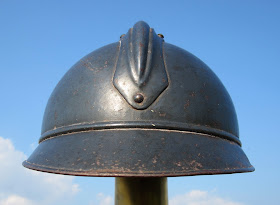During the Second World War, these people...

took to the skies to fly over England (and, many feared, Canada) to kill their enemies, who were...
Those younger people were...
And here is the warden's trusty helmet, the standard British MkII in warden livery.
 The letter painted on the front identified the responsibilities of the wearer. "W" for air raid warden, "A" for ambulance service, "RP" for rescue party, and so on. Paolo Marzetti has a two-page spread of most of these helmet markings in his outstanding work "Combat Helmets of the World".
The letter painted on the front identified the responsibilities of the wearer. "W" for air raid warden, "A" for ambulance service, "RP" for rescue party, and so on. Paolo Marzetti has a two-page spread of most of these helmet markings in his outstanding work "Combat Helmets of the World".  Side view provides that very familiar "battle bowler" profile.
Side view provides that very familiar "battle bowler" profile. Note that the finish is without any non-reflective sand or sawdust. Simply a coat of brownish green paint.
Note that the finish is without any non-reflective sand or sawdust. Simply a coat of brownish green paint. Sadly, mine is missing its liner, though I'm still very happy to have this particular piece in my collection. Usually I like to collect the best specimen possible, though sometimes I find that that means the only specimen available.
Sadly, mine is missing its liner, though I'm still very happy to have this particular piece in my collection. Usually I like to collect the best specimen possible, though sometimes I find that that means the only specimen available. The manufacturers mark is stamped underneath the brim, in this instance its of Canadian manufacture.
The manufacturers mark is stamped underneath the brim, in this instance its of Canadian manufacture. The rim seam butts neatly in the rear of the helmet.
The rim seam butts neatly in the rear of the helmet. The MkII spring-loaded chinstrap; here, relaxed...
The MkII spring-loaded chinstrap; here, relaxed...
and here, extended. This strap in is very good condition.
 The buckle is highly enameled and lustrous.
The buckle is highly enameled and lustrous. Stenciled proudly on the front is the Warden's insignia. Take that you motherless Nazi swine!
Stenciled proudly on the front is the Warden's insignia. Take that you motherless Nazi swine!
provenance:
accession number: MOA hmar219.26
MkII British ARP Warden Steel Helmet
Acquired 1983, Grand Rapids Michigan.
Purchase price :$16.00
Condition: excellent though liner is missing
Attention Readers:
Give me your input! For my next series of helmet posts what would you prefer to see: Spanish helmets of the Spanish Civil War and beyond or Mk1 helmets of the U.S. Navy of WWII and beyond?



























